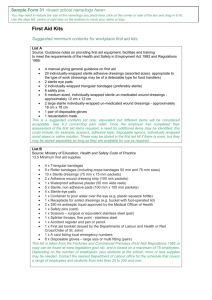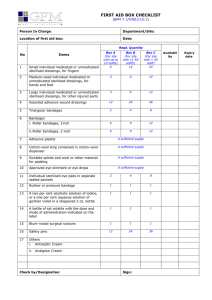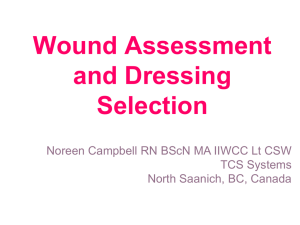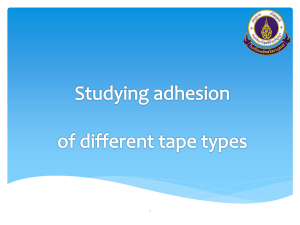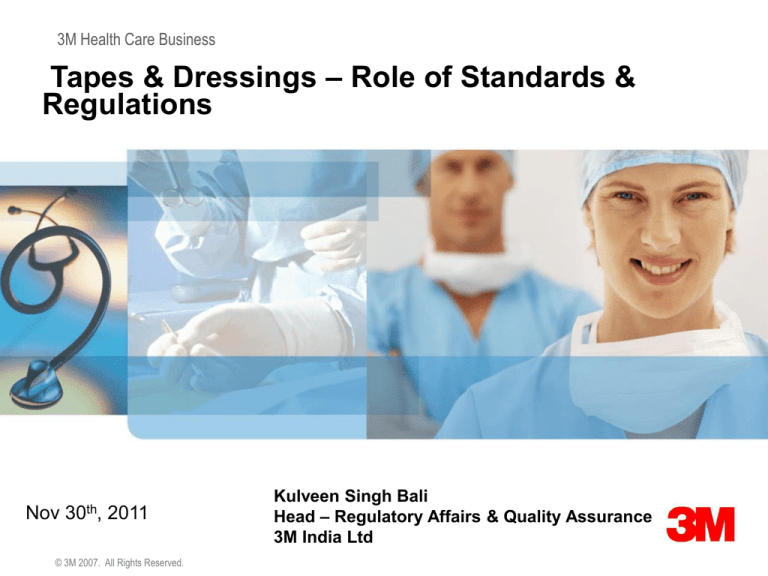
3M Health Care Business
Tapes & Dressings – Role of Standards &
Regulations
Nov
30th,
2011
© 3M 2007. All Rights Reserved.
Kulveen Singh Bali
Head – Regulatory Affairs & Quality Assurance
3M India Ltd
Contents
Development of Tapes & Dressings over the ages
Applications
Regulatory Status
Standards supporting Tapes & Dressings
Support required
2
© 3M 2007. All Rights Reserved.
Ants to the rescue - Apocalypto
History records use of ants in wound healing
The ant were positioned with their mandibles across
the edges of the wound
When the ant ‘bit’ the mandibles would close thereby
‘stapling’ the wound edges together .
The thorax would then be pinched off leaving the head
(and the mandibles) in the body.
Carpenter, Leaf – cutting and Army ants have been
known to this category.
3
© 3M 2007. All Rights Reserved.
Emergence of Tapes
Hieroglyphics describe how Egyptian healers recognised
need for adhesives to help them heal wounds. They prepared
pastes of olive oil, water, beeswax and lead oxide.
Adhesive strapping was made by applying gum to strips of linen.
The cure might have been worse than the disease!
4
© 3M 2007. All Rights Reserved.
Cloth Tape
In the Middle Ages pastes and cloth strips
were used for tape wound closures - the
precursor of Steri-Strips,
of medieval wound closures.
These cloth strips were adhered
to the skin to close the wound and
approximate the edges.
5
© 3M 2007. All Rights Reserved.
Cotton Bandages
Cotton Bandages, with / without cotton wadding developed
and still is, in certain sections, used in course of wound
management
6
© 3M 2007. All Rights Reserved.
First cloth Tape with Rubber and Zinc Adhesive
More than 100 years ago Paul Beiersdorf, a
German chemist, invented the first pressure
sensitive medical tape. It was composed of a
woven cotton backing and an adhesive
composed of natural rubber and included
Zinc Oxide.
Zinc Oxide was included to improve the
tolerance of the adhesive.
7
© 3M 2007. All Rights Reserved.
Skin – The Largest and Most Complex Human Organ
Skin is not flat. It has hills and valleys.
Initially, the tape only sticks to the highest points of
the skin. Conforming to the skin contour takes time.
8
© 3M 2007. All Rights Reserved.
With time, the adhesive will flow
into the contours of the skin
resulting in increased adhesion
Tapes & Dressings - Applications
9
© 3M 2007. All Rights Reserved.
One Tape does not meet all requirements
Level of Adhesion
Importance of secural
Activity level/ strain
Part of the body
Contoured vs flat
Subject to stress: friction,
shear, pulling, picking
Potential for skin to stretch,
edema, distention, movement
Durapore
Skin condition
Dry vs Moist or Oily
Intact vs ‘at-risk’ vs damaged
Length of wear
Short time
1-2 or more days
10
© 3M 2007. All Rights Reserved.
Micropore
Medipore H
11
© 3M 2007. All Rights Reserved.
Regulatory Status
India
Current scenario – Bandages are regulated Schdl F (II) under the Drugs &
Cosmetics Act
World wide
Tapes are regulated as Medical Devices – Class I / Class II depending upon
region, sterile / non sterile and intended use
Manufacturing
Good Manufacturing Practices (GMP) – Controlled Environment Area, Gowning,
Validation and Process Controls
12
© 3M 2007. All Rights Reserved.
Standards
Product Standards are limited to Manufacturers claims
within the requirements of ISO 10993, 14791, 11135, 11136
and other relevant standards like ASTM and others.
Being engineered devices, Validation plays a key role in
ensuring patient safety and efficacy of the product.
13
© 3M 2007. All Rights Reserved.
Product Design Requirements
Customer Requirements
Holding Power
Technical Parameters
Adhesion
Backing Strength
No Skin irritation
Comfort
Design / Customization
Sterility
Should meet ISO 11135 requirements
Brand
Quality assurance
14
© 3M 2007. All Rights Reserved.
Cytotoxicity and primary skin irritation
test
Hypoallergenic
ISO 10993, ISO 14791
Conformability / High MVTR
Backing material
Specific designs to suit standard
surgical procedures, no change in
practice
ISO 13485
Validations & Testing
Design
Installation
Operation
Performance
a
a
a
a
Validations as per International Standards ensures the Performance
of the product as per Design
Quality Control is achieved through a Strong Regime of Tests
Organisations like SITRA, with its complement of test facilities to be
encouraged to establish Design, Installation , Operation and
Performance standards for development of Medical Textiles in the
country
15
© 3M 2007. All Rights Reserved.
Support Required from Government
Ensuring a Market for Medical Textiles through issuance of guidelines
Creating awareness amongst users on the important role played by engineered
medical textiles in Infection Prevention & Promoting Healthcare
Establishing regulatory framework for Medical Devices
Encouraging greater collaboration between medical and technological centers
Including Medical Technology in Medical Curriculum
• Evolve medical technology clusters with common facilities for testing, quality,
waste treatment etc
• Assist Indian medical technology companies to upgrade to adhere to International
Standards
16
© 3M 2007. All Rights Reserved.
Thank You
17
© 3M 2007. All Rights Reserved.

